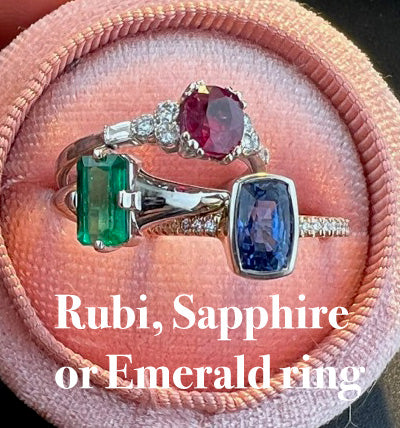The Ultimate Guide How to Buy a Lab-Grown Diamonds: 5 Simple Steps
Are you in search of the perfect diamond engagement ring or piece of ethical diamond jewelry? Look no further! Lab-grown diamonds have become a popular alternative to mined diamonds, offering the same beauty and durability but without the negative environmental and social impacts.
This easy-to-follow guide will walk you through five essential steps to help you find the perfect lab-grown diamond for your unique style and budget. We'll cover everything from understanding lab-grown diamonds to making a well-informed decision, ensuring you're ready to make a confident choice.
Step 1. Understand Lab-Grown Diamonds
Lab-grown diamonds, also known as synthetic or cultured diamonds, are created through highly controlled scientific processes that mimic the natural conditions under which diamonds form in the Earth's mantle. Two primary methods are used to create these diamonds: High Pressure High Temperature (HPHT) and Chemical Vapor Deposition (CVD). Both processes result in diamonds with virtually the same chemical composition, crystal structure, and physical properties as natural diamonds. CVD are most popular in diamond engagement rings since they will test as positive with conventional diamond testers. HPHTs won’t. CVDs will have a higher value compared to HPHT. Lab-grown diamonds offer an environmentally friendly and ethically responsible alternative to mined diamonds, as they require less energy and resources to produce and do not involve the negative social and environmental impacts associated with mining.
Check out this blow we wrote about the difference between Lab diamonds and Natural diamonds to learn more about the science behind lab-grown diamonds and their benefits compared to mined diamonds.
Also for technical information about lab grown diamonds click here.
Step 2. Set a Budget
Before you start shopping for a lab grown diamond, it's essential to establish a budget, how much maximum would you like to spend. Diamonds are priced based on their size (carat weight) and quality (cut, color, and clarity). Lab grown diamonds tend to be more affordable than natural diamonds, often costing 30-50% less for a similar quality stone. When setting a budget, consider the importance of the diamond's size and quality, as well as the type of metal for the setting and any additional design elements. Be realistic about your financial situation and remember that a lab-grown diamond can offer excellent value without compromising on beauty or quality. $300 can make a big difference in size or quality when it comes to lab grown diamonds so set a maximum spending limit.
Step 3. Choose a Reputable Seller
To ensure you're purchasing a high-quality lab-grown diamond, it's crucial to select a reputable seller. Look for retailers that provide diamonds certified by well-known gemological laboratories, such as the Gemological Institute of America (GIA) or International Gemological Institute (IGI). These certifications confirm the diamond's origin, as well as its quality based on the 4Cs. Additionally, seek out retailers with transparent pricing, clear return policies, and excellent customer service. Consult online reviews and recommendations from friends or family members to help identify trustworthy sellers.
Step 4. Learn the 4Cs
When evaluating lab-grown diamonds, focus on the 4Cs: carat, cut, color, and clarity. Carat refers to the diamond's weight, with larger carat weights typically commanding higher prices. Cut, arguably the most crucial factor, determines how well the diamond interacts with light, affecting its brilliance, fire, and scintillation. Well cut diamonds exhibit better sparkle and visual appeal. Color in diamonds refers to the presence of any hues; for white diamonds, a colorless or near-colorless grade is preferred. Lastly, clarity measures the number and size of inclusions (internal imperfections) and blemishes (external imperfections) in the diamond. Higher clarity grades signify fewer visible flaws. Understanding the 4Cs will help you compare and select the best lab-grown diamond within your budget.
Check out this helpful link for more information on the 4Cs.
Step 5. Make a Decision
After gaining a solid understanding of lab-grown diamonds, setting a budget, choosing a reputable seller, and familiarizing yourself with the 4Cs, you're ready to make a decision. Consider your personal preferences and the purpose of the diamond, whether it's for an engagement ring, a gift, or a personal investment. Take your time to compare different diamonds, weighing their quality against your budget. When you find a lab-grown diamond that aligns with your preferences and budget, move forward with the purchase, knowing you've made an informed decision. Keep in mind the importance of the setting and any additional design elements, ensuring that your chosen diamond is showcased beautifully and securely. By following this first principles approach, you can confidently purchase a lab-grown diamond that suits your needs and represents excellent value.
In conclusion, these 5 steps will empower you to make a well-informed decision when purchasing a lab-grown diamond. By focusing on the essential elements and following the five steps outlined in this blog, you'll be able to navigate the process with confidence and ease. Embracing this method ensures that you not only invest in a stunning and ethical gemstone but also contribute to a more sustainable and responsible future for the diamond industry. As you celebrate your love story and mark life's most precious moments with a lab-grown diamond, you'll be reminded of the thoughtful and informed choices that led you to this beautiful and lasting symbol of your commitment.
At Oscargama Jewelry We are a small shop based in NYC and we'll be happy to answer all your questions. We use only reputable diamond dealers. All our lab grown diamonds are GIA and IGI certified and all our jewelry is made in our shop in NYC.
If you have any questions or need answers feel free to contact me at Info@oscargama.com


